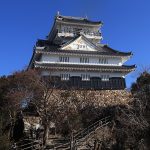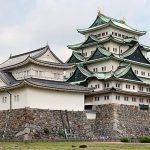Castles in Aichi

Nagoya and Aichi are often overlooked in their historical significance, especially compared to other Japanese cities like Osaka, Kyoto, and Tokyo. However, the region played a crucial role in the birth of Japan. It was the birthplace or home to many notable figures in Japanese history, including Oda Nobunaga, Toyotomi Hideyoshi, and Tokugawa Ieyasu. As a result, the area offers visually striking castles, significant to the country’s heritage and worthy of examination.
Nagoya Castle
Nagoya Castle is a significant historical site that was once the largest and most magnificent castle in Japan. Its construction, under the direction of Tokugawa Ieyasu in 1610-1612, was an impressive feat of strategic and architectural design. The dual keeps connected by a high-walled walkway, and the array of karahafu and triangular roof features made it an iconic symbol of Nagoya City. The castle also featured distinctive 18 Karat golden shachi, dolphin-like ornaments, which added to its grandeur.
During the construction process, various daimyo, or feudal lords, contributed labor and materials, which was a clever tactic by Ieyasu to limit the resources of potential rivals. The castle’s walls bear the crests of these daimyo, marking their allegiance and contributions. One of the most significant elements of the construction was the Kiyomasa Stone, named after Kato Kiyomasa, a renowned samurai architect who played a key role in the castle’s design, making it one of Japan’s most impregnable fortresses.
Unfortunately, much of Nagoya Castle, including its turrets, gates, walls, and palaces, was destroyed in the American air raids of May 14, 1945, during World War II. However, some parts survived, like the Southwest Hitsuji Saru tower, the Tatsumi turret, and the Omote Ninomon Gate. The castle also features unique defensive elements like the “Wall of Swords,” designed to deter ninja attacks.
Nagoya Castle has more to offer beyond its structure. It’s located near the birthplace of Oda Nobunaga, marked within the Ni no Maru, or Second Citadel. The castle’s complex history extends to the dismantling of nearby Kiyosu Castle, whose main keep was relocated to Nagoya Castle to serve as a watchtower. The castle offers a range of exhibits, from a recreated castle town environment to displays of samurai armor and weapons. The top floor serves as an observation deck, offering a panoramic city view.
In 2019, the Honmaru Goten Palace reconstruction project was completed, restoring the magnificence of the Nagoya Castle grounds. Honmaru Goten Palace is renowned for its samurai-style architecture in Japan and has influenced many other buildings, including the Ninomaru Palace in Nijo Castle, Kyoto. The use of traditional woodwork techniques and master artisan skills highlights a commitment to authenticity, not only in recreating the physical structure of the original palace built by shogun Tokugawa Ieyasu in 1615 but also in reviving the essence and atmosphere of the era.
The palace’s interior is a testament to the opulence of the period. Walls and sliding doors are adorned with lavish gold leaf and intricate paintings. Such attention to detail immerses visitors in the grandeur of the past.
The use of hinoki cypress wood, consistent with the materials used 400 years ago, is particularly significant. This choice is not merely aesthetic or structural; it is also sensory. The fragrance of the cypress, combined with the extensive use of wood, is designed to transport visitors back in time, offering a glimpse into what it would have been like to be a royal guest in the original palace.
Visitors can also enjoy the surrounding gardens, traditional tea rooms, and a hunt for crests on the stone walls. Nagoya Castle, in its reborn form, continues to be a symbol of pride for Nagoya City, offering a rich historical experience to those who visit.
Inuyama Castle
Inuyama Castle is a remarkable testament to Japan’s architectural and feudal heritage, with a rich history dating back to the 15th century. It is strategically located on a wedge-shaped hill by the Kiso River. It offers panoramic views of surrounding areas, including Nagoya, Komaki, and Gifu castles, highlighting its historical significance in military strategy.
The castle’s modest size is characteristic of the keeps of that era, with stone walls of just five meters in height and a tower extending 19 meters above. The keep, or the main watchtower, remains at the heart of a larger complex that once included the lord’s living quarters, turrets, barracks, and extensive fortifications.
To enter the interior of the castle, one must remove their shoes. Its wooden floorboards and pillars witnessed the lives of prominent historical figures like Oda Nobunaga and Toyotomi Hideyoshi. The steep stairs, intended to hinder armor-clad invaders, and various chambers, including a lord’s office with hidden doors for bodyguards, reflect both the architectural beauty and the defensive considerations of the time.
Inuyama Castle played a significant role in historical events, such as serving as Toyotomi Hideyoshi’s base during the Battle Of Komaki Nagakute, which adds to its importance. Despite the destruction of many outer walls and buildings in 1871 and further damage in the Great Nobi Earthquake of 1891, the castle was restored and eventually designated a National Treasure in 1935.
The castle’s journey through various owners, finally resting in the hands of Inuyama City and a new overseeing foundation in 2004, speaks to its enduring legacy. Inuyama Castle is one of the few original castles remaining in Japan. As a rare example of 16th-century castle architecture, it is a treasured piece of history for the residents of Inuyama City and beyond.
Website (Japanese)
Kiyosu Castle
Kiyosu Castle, an important fortress during the Sengoku Jidai period (1450-1615), is located in Aichi Prefecture, Japan. The castle played a significant role in several critical samurai battles, and its history is intertwined with some of Japan’s most influential warlords.
The castle was constructed between 1394 and 1427 and initially served as a defensive stronghold and later as the power center for the Owari region. After being captured by Oda Nobunaga in 1555, it became the center of his military operations and economic reforms, contributing to the city’s flourishing status. The castle was extensive and had an intricate moat system.
Kiyosu Castle played a crucial role in Japan’s unification, with Nobunaga using it as a launching pad for several key battles. It was the starting point for the major conflicts of Okehazama in 1560, Anegawa in 1570, Nagashino in 1575, and Sekigahara in 1600, underscoring its critical role in Japan’s unification.
The castle’s significance declined in 1610 when the seat of government shifted to Nagoya with the completion of the magnificent Nagoya Castle. This move, coupled with Tokugawa Ieyasu’s decree limiting each Han (prefecture) to one castle, led to the dismantling of many castles, including Kiyosu. However, the main castle keep was not destroyed but relocated as a turret on Nagoya Castle’s northwestern corner, a structure that survived World War II’s aerial bombings.
Today, Kiyosu Castle stands across a small river from its original site. The castle was rebuilt in concrete in 1989 and now serves as a museum, offering fascinating displays and artifacts that narrate its role in the Sengoku Jidai. Visitors are encouraged to explore the original castle site, traverse the red bridge, and immerse themselves in the local history, further accentuated by surrounding old dwellings and warehouses, accessible with a Kiyosu history walking map available at the castle.
Despite the vicissitudes of time and the march of modernity, Kiyosu Castle remains a potent symbol of Japan’s tumultuous past and a must-visit destination for those seeking to understand the complexities of the Sengoku Jidai.
Website (Japanese)
Okazaki Castle
In the heart of Aichi Prefecture, a region known as the birthplace of some of Japan’s most influential figures from the Sengoku period, stands the Okazaki Castle. This iconic structure symbolizes the legacy of heroes like Oda Nobunaga, Toyotomi Hideyoshi, and Tokugawa Ieyasu, all born in or near this historic locale.
The Okazaki Castle’s beginnings date back to 1455 when the warrior Saigo Tsugiyori erected a small wooden fort near the current Myodaiji Temple. The castle’s strategic importance surged under the guidance of Kiyoyasu, Ieyasu’s grandfather. He captured the fortress and rebuilt Okazaki Castle in 1531 on its present site, effectively utilizing the Otogawa river and a tributary as natural moats.
Over the years, the castle underwent significant expansions and fortifications, evolving into one of Japan’s most esteemed castles, respected for its defensive prowess. For over 350 years, it stood as the stronghold of the Tokugawa clan and was the seat of the Mikawa Tokugawa, one of the three main family lines, throughout the Edo Period (1603-1868).
The castle is most notable for being the birthplace of Tokugawa Ieyasu in 1542, a period marked by intense civil unrest. The Tokugawa, then known as the Matsudaira, controlled the rice-rich Mikawa plains, making the region a target for surrounding warlords. Ieyasu emerged as a brilliant tactician and leader, successfully maintaining and expanding his territories. Following his victory at the Battle of Sekigahara in 1603, he was appointed Shogun, establishing a hereditary title that would see the Tokugawa family rule Japan for the next 250 years.
During the Edo Period, Okazaki flourished as an important castle town on the Tokaido Highway, the principal route between Kyoto and Ieyasu’s stronghold, Edo (modern-day Tokyo). However, the abolition of the feudal system in 1868 and the samurai caste in 1876 led to the demolition of Okazaki Castle in 1873, leaving only the moat and stone walls. The castle’s main keep, annex, and well-house were reconstructed in ferro-concrete in 1959.
Today, the Okazaki Castle’s grounds are a lush park popular for cherry blossom and wisteria viewing. The site includes the striking Otemon gate, impressive stone walls, statues of Ieyasu and Honda Tadakatsu, Japan’s oldest municipal Noh theatre, various shrines, eateries, an ancient teahouse, and a monument to the Alamo. The Ieyasu and Mikawa Bushi Museum offers further insights into the area’s history, and visitors might encounter the Great Ieyasu Aoi Busho Tai performing samurai.
The castle keep now houses a museum with samurai armor, weapons, local history exhibits, and an observatory offering panoramic views of the Mikawa region.
Website (Japanese)
Komaki Castle
Komaki Castle, with its historical significance and picturesque setting, offers a fascinating glimpse into Japan’s rich past. Perched atop an 86-meter hill, it provides a commanding view of the Nobi Plain and is located near the former Nagoya International Airport, now known as Komaki Airport. Although smaller than other reconstructed castles, its allure for history and castle enthusiasts is undeniable.
The castle’s origins date back to 1563 when Oda Nobunaga established it as an alternative to Kiyosu Castle. Notably, it was his third castle after his birthplace in Nagoya and served as his headquarters until 1567, following his conquest of the Mino province.
After Nobunaga’s death, Komaki Castle became the focal point of the Battle of Komaki and Nagakute in 1584. This conflict, initiated as a siege, pitted Nobunaga’s general, Toyotomi Hideyoshi, against his former ally, Tokugawa Ieyasu.
Today, the mountain and its surroundings, spanning about 21 hectares, are preserved as a National Historical Site, transformed into a verdant park. The reconstructed three-story castle, completed in 1968, blends modern concrete construction with historical design. Despite limited English information and modest displays, the castle offers intriguing relics and an informative diorama of the historic battle. While it may not rival Inuyama Castle in grandeur, Komaki Castle’s charm lies in exploring its remnants, like stone walls and ancient wells. The panoramic views from the top, coupled with a stroll through the woods, make for a delightful experience. Particularly noteworthy is the springtime cherry blossom and the presence of the rare Persea tree.
Website (Japanese)
Photo: wikipedia Imuyama Castle (CC BY-SA 3.0)



